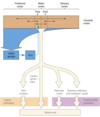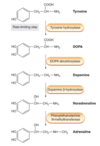Introduction to CNS pharmacology Flashcards
(126 cards)
Diagram of Chemical Neurotransmission

Diagram of when neurons reach a threshold potential.
What’s notable about the discovery of drugs which treat CNS disorders?
Much of the discovery of drugs to treat CNS disorders has been serendipitous (i.e. based on luck)
Give a few examples of serendipity in CNS drug discovery.
- The first antiepileptic drug (phenobarbital) was prescribed as a sedative but had anticonvulsant properties
- The first antipsychotic drug (Thorazine) was also prescribed as a sedative but stopped hallucinations
- The first antidepressant drug (imipramine) came from a failed attempt to develop a new antipsychotic drug
What are astrocytes?
Astrocytes maintain nutrition and regulate ionic concentrations. They also play a role in neurotransmitter synthesis and metabolism.
What do Oligodendrocytes do?
Oligodendrocytes (& Schwann cells in the periphery) produce myelin (inset) that insulates nerve cell membranes.
What is the function of Microglia?
Microglia act like macrophages, scavenging unwanted materials from the brain. They proliferate in disease states.
What are some of the neurotransmitters in the CNS?
Amines
- Dopamine
- Serotonin
- Noradrenaline
Amino Acids
- Dopamine
- Serotonin
- Noradrenaline
- Histamine
Cholinergic
- Acetylcholine
Purines
- ATP
- Adenosine
Peptides
- Enkephalins & endorphins
- Vasoactive intestinal polypeptide (VIP)
- Substance P
- Cholecystokinin (CCK)
- Opioids
Some neurotransmitters have well-defined roles (e.g. glycine), but many have complex and overlapping functions (e.g. amines in emotion and cognition).
How are neurons defined?
Neurons are largely defined by the neurotransmitter that they release.
List of receptors and the receptors subtypes.
Dopamine: D1, D2, D3, D4, D5
Serotonin: 5HT1A/1B/1D/1e/1F, 5HT2A/2C, 5HT3A/3B/3C/3D/3E, 5HT4, 5HT5A, 5HT6, 5HT7
Noradrenaline: a1A/1B/1D, a2A/2C,b1, b2
Glutamate: AMPA (GluA1-4), NMDA (GluN1, GluN2A-D, GluN3A/3B), kainate (GluK1-5), metabotropic (mGlu1-8)
GABA: GABAA (a1-6, b1-3, g1-3, d, e, q, p, r1-3), GABAB1/B2
Acetylcholine: nicotinic (a2/3/4/5/6/7/9, b2/3/4), muscarinic (mostly M1, M4, M5)
Purines: A1, A2A, A3, P2X1/2/3/7, P2Y1/2/4/6/11/12/13/14
Tachykinins: NK1, NK2, NK3
Opioids: u, k, d, ORL1
Impossible to remember them all but try to remember those that are ligand-gated ion channels and those that are GPCRs.
What are some of the technical issues with neuropharmacology?
Technical issues
- Tissue baths cannot be used, so instead researchers use:
- Electrophysiology
- Lesion studies
- Genetic techniques (KO mice, siRNA, etc.)
- Behavioral effects of selective drugs
- Very few reliable animal models; can’t biopsy tissue
- Outputs are hard to measure both in humans and animal models (although for different reasons)
- Using induced pluripotent stem cells derived neurons to model brain diseases
Most of the techniques above are NOT unique to neuropharmacology (e.g. electrophysiology); the difference mainly lies in what cannot be done in the brain.
Describe the plasticity within the CNS?
- The brain (and its pharmacology) continues to develop into adulthood
- The information the brain stores and processes change constantly
- Continued post-natal migration of cells and development of connections
- Changes in the strength of connections throughout life, e.g. long-term potentiation & depression
- Neurogenesis (in specific brain regions)
What is the Blood-Brain Barrier?
The blood-brain barrier (BBB) is a crucial immunological feature of the human central nervous system (CNS). Composed of many cell types, the BBB is both a structural and functional roadblock to microorganisms, such as bacteria, fungi, viruses, or parasites, that may be circulating in the bloodstream.
Give some of the features of the Blood-Brain Barrier.
- Continuous endothelium
- Tight junctions & basal membrane
- Lack of fenestrations
- Pericytes and astrocytes
- Few pinocytotic vesicles
- High metabolic rate
- Drug transporters
- Drug metabolizing enzymes
- The brain is inaccessible to many drugs (~85%); the drug requires high lipid solubility.
- The BBB is weak at the postrema
- During a brain infection, the Blood-Brain Barrier is compromised.
Types of Dementia
- Alzheimer’s disease (>50% of cases)
- Multiple cerebral infarcts (Vascular dementia) 20%
- Dementia with Lewy bodies (15%)
- Frontotemporal dementia (5%)
What are some causes of dementia?
- Parkinson’s/Huntingdon’s/Pick’s disease
- Prion disease (e.g. CJD)
- Alcoholism (Wernicke-Korsakoff), syphilis, HIV
- Other damage/metabolic or vit B deficiency etc
What’s the most common form of senile dementia in the USA population incidence?
0.1% at 60 (early onset)
Rising to 10% by age 80 (Late-onset)
Rising to over 30% by age 90 (Alzheimer’s Disease)
Alzheimer’s symptoms.
- Onset may be very slow and gradual or rapid
- 4-12 years(7-10 most common)
‘Gradual onset and continuing decline of cognitive function from a previously higher level resulting in impairment of social and occupational function’
- Decrease in the following:
- Memory
- language
- Perceptual abilities
- 1st symptom = loss of recent memory and inability to store recent information in long term memory
Common Symptoms of Alzheimer’s by stage.

The Aetiology of Alzheimer’s
A number of environmental and genetic risk factors may be involved e.g.
- head trauma
- exposure to aluminium
- family history of Down’s syndrome
- cerebrovascular disease
- Increasing age
- Gender-specific? ( 2x at risk thanbut live longer!)
- Genetic mutation/s
Describe the Neuropathology when the brain is in the disease state of Alzheimer’s.
- Neurone degeneration and death occurs in the hippocampus & the amygdala (subcortical limbic system)
- mainly regions of the brain that function in memory and learning.
- Massive cell loss and brain shrinkage
- Atrophy in parts of the cerebral cortex
- Thinned temporal lobes and ventricle size
What is the Limbic System?
The limbic system is the part of the brain involved in our behavioural and emotional responses, especially when it comes to behaviours we need for survival: feeding, reproduction and caring for our young, and fight or flight responses.
What does the limbic system consist of and how is it affected by Alzheimer’s?
The limbic system consists of a number of structures, including the fornix, hippocampus, cingulate gyrus, amygdala, parahippocampal gyrus, and parts of the thalamus. The hippocampus is one of the first areas affected by Alzheimer’s disease. As the disease progresses, the damage extends throughout the lobes.
Diagram of the Gross Anatomical Pathology of Alzheimer’s





























